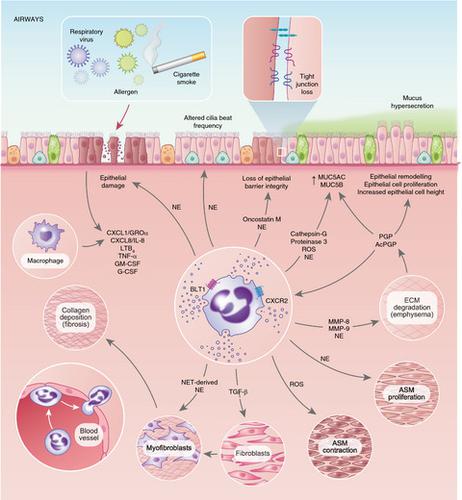当前位置:
X-MOL 学术
›
Immunology
›
论文详情
Our official English website, www.x-mol.net, welcomes your feedback! (Note: you will need to create a separate account there.)
Our evolving view of neutrophils in defining the pathology of chronic lung disease
Immunology ( IF 6.4 ) Pub Date : 2021-09-21 , DOI: 10.1111/imm.13419 Kyle T Mincham 1 , Nicoletta Bruno 1 , Aran Singanayagam 1, 2 , Robert J Snelgrove 1
Immunology ( IF 6.4 ) Pub Date : 2021-09-21 , DOI: 10.1111/imm.13419 Kyle T Mincham 1 , Nicoletta Bruno 1 , Aran Singanayagam 1, 2 , Robert J Snelgrove 1
Affiliation

|
Neutrophils are critical components of the body's immune response to infection, being loaded with a potent arsenal of toxic mediators and displaying immense destructive capacity. Given the potential of neutrophils to impart extensive tissue damage, it is perhaps not surprising that when augmented these cells are also implicated in the pathology of inflammatory diseases. Prominent neutrophilic inflammation is a hallmark feature of patients with chronic lung diseases such as chronic obstructive pulmonary disease, severe asthma, bronchiectasis and cystic fibrosis, with their numbers frequently associating with worse prognosis. Accordingly, it is anticipated that neutrophils are central to the pathology of these diseases and represent an attractive therapeutic target. However, in many instances, evidence directly linking neutrophils to the pathology of disease has remained somewhat circumstantial and strategies that have looked to reduce neutrophilic inflammation in the clinic have proved largely disappointing. We have classically viewed neutrophils as somewhat crude, terminally differentiated, insular and homogeneous protagonists of pathology. However, it is now clear that this does not do the neutrophil justice, and we now recognize that these cells exhibit heterogeneity, a pronounced awareness of the localized environment and a remarkable capacity to interact with and modulate the behaviour of a multitude of cells, even exhibiting anti-inflammatory, pro-resolving and pro-repair functions. In this review, we discuss evidence for the role of neutrophils in chronic lung disease and how our evolving view of these cells may impact upon our perceived assessment of their contribution to disease pathology and efforts to target them therapeutically.
中文翻译:

我们对中性粒细胞在定义慢性肺病病理学方面的演变观点
中性粒细胞是机体对感染的免疫反应的重要组成部分,装载着强大的有毒介质库,并显示出巨大的破坏能力。鉴于嗜中性粒细胞有可能造成广泛的组织损伤,当这些细胞增加时,它们也与炎症性疾病的病理学有关,这也许并不奇怪。显着的中性粒细胞炎症是慢性阻塞性肺病、严重哮喘、支气管扩张和囊性纤维化等慢性肺病患者的标志性特征,其数量通常与较差的预后相关。因此,预计中性粒细胞是这些疾病病理学的核心,并代表有吸引力的治疗靶点。然而,在许多情况下,将嗜中性粒细胞与疾病病理学直接联系起来的证据在某种程度上仍然是间接的,并且在临床上寻求减少嗜中性粒细胞炎症的策略在很大程度上被证明是令人失望的。我们传统上将中性粒细胞视为有点粗糙、终末分化、孤立和同质的病理学主角。然而,现在很明显,这对中性粒细胞不公平,我们现在认识到这些细胞表现出异质性、对局部环境的明显意识以及与大量细胞相互作用和调节其行为的非凡能力,甚至具有抗炎、促分解和促修复功能。在这篇评论中,
更新日期:2021-11-04
中文翻译:

我们对中性粒细胞在定义慢性肺病病理学方面的演变观点
中性粒细胞是机体对感染的免疫反应的重要组成部分,装载着强大的有毒介质库,并显示出巨大的破坏能力。鉴于嗜中性粒细胞有可能造成广泛的组织损伤,当这些细胞增加时,它们也与炎症性疾病的病理学有关,这也许并不奇怪。显着的中性粒细胞炎症是慢性阻塞性肺病、严重哮喘、支气管扩张和囊性纤维化等慢性肺病患者的标志性特征,其数量通常与较差的预后相关。因此,预计中性粒细胞是这些疾病病理学的核心,并代表有吸引力的治疗靶点。然而,在许多情况下,将嗜中性粒细胞与疾病病理学直接联系起来的证据在某种程度上仍然是间接的,并且在临床上寻求减少嗜中性粒细胞炎症的策略在很大程度上被证明是令人失望的。我们传统上将中性粒细胞视为有点粗糙、终末分化、孤立和同质的病理学主角。然而,现在很明显,这对中性粒细胞不公平,我们现在认识到这些细胞表现出异质性、对局部环境的明显意识以及与大量细胞相互作用和调节其行为的非凡能力,甚至具有抗炎、促分解和促修复功能。在这篇评论中,


























 京公网安备 11010802027423号
京公网安备 11010802027423号